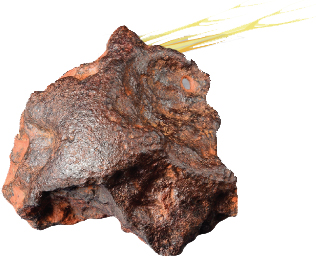

Classification of meteorites is quite a complicated process, involving many categories and subcategories. They have traditionally been classified into three broad categories: stone (the majority), iron and stony-iron, depending on their composition. However, there are many further factors and refinements that come into consideration, relating not only to meteorites’ more detailed composition but also to their origins and recovery. The information below covers most of the different types but some less common varieties have not been included to avoid over-complication. Full details for each category and the multitude of subcategories are provided by Norton & Chitwood (2008).
The irons, as the name suggests, are virtually solid metal and comprise a mixture of iron and nickel with traces of other materials. These meteorites originate from the core of a former ‘planet’ from the asteroid belt between Mars and Jupiter. They represent approximately 6% of all meteorites found on Earth by number of falls and finds, but almost 90% by weight. Approximately 930 individual iron meteorite falls or finds have been classified and, despite the relatively low number, the combined mass of the recovered meteorites is estimated at over 594t. The actual weight of iron meteorites recovered so far is likely to be significantly higher, since the total known weight of some of the most common iron meteorites was estimated many years ago, and since then numerous additional specimens have been found that are not reflected in the original statistics.
Since these meteorites consist mainly of iron, they tend to rust easily once they have landed on Earth and do not last for long in wet and humid areas. In dry areas, however, they can remain intact for hundreds, if not many thousands, of years. Some of the most common iron meteorites, such as the Gibeon (on page 89) are thought to have fallen thousands of years ago and have survived due to the dry desert conditions prevailing in the strewn field since their arrival on Earth. The Hoba meteorite from Namibia, for example, is estimated to have fallen to Earth over 80,000 years ago.

Viacheslav Kalachev
This Seymchan meteorite illustrates the typical appearance of an iron meteorite as it is usually found in the field: a heavy, rusty lump of iron, indicating it has been lying in the strewn field for many years. The level of rusting will depend on the presence of moisture and the length of time the meteorite has been on Earth.

Viacheslav Kalachev
Many collectors prefer to keep meteorites in the condition in which they were recovered from the field, such as this Seymchan of 80kg.
Iron meteorites are the heaviest of the meteorites and weigh approximately the same as lumps of solid iron, which is what one would expect from something that is a mixture of iron and nickel. If someone finds a ‘meteorite’ that is even heavier than a lump of solid iron, then it is most likely not a genuine meteorite (see the section on page 40 on ‘meteorwrongs’). Some collectors like to keep their stones in the original condition in which they are found, with their rusty outer layer intact. Others prefer to clean off the outer layer to reveal the clean metal beneath. In collections around the world, most Gibeon meteorites that have been cleaned have either a black metal finish or are brown with a typical desert patina.

Bruce Cairncross
Some collectors prefer to clean off the outer rusty layer to uncover the clean metal beneath. Here’s an example of an iron meteorite that has been cleaned to a gunmetal finish: a Gibeon iron; 27kg. This meteorite was originally found as a brown, rusty specimen and after many hours of careful brushing, it cleaned up to form a stunning grey/black iron meteorite.

Bruce Cairncross
A small (197g) but exquisite, beautifully oriented Henbury iron; 197g

Bruce Cairncross
An interestingly shaped iron meteorite that seems to have a personality of its own – a Taza iron; 1,300g

Bruce Cairncross
A well crusted Sikhote Alin iron; 130kg
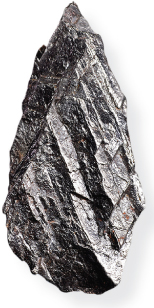
Bruce Cairncross
Some meteorites break along the bands of crystallisation and the resulting specimens often show a clear crystal structure, such as this Gibeon ‘crystal’ of 355g; 100mm tall. They are popular with collectors and command a premium when being purchased or sold.
In cases where iron meteorites are found relatively soon after they have fallen to Earth, such as the Sikhote Alin meteorite, they may exhibit the original black fusion crust that is formed when they pass through the atmosphere. Many of these show a perfect black glassy crust, which should be kept well oiled to prevent oxidation.
There are many subcategories of iron meteorites, with at least 14 different types that have been officially recognised. For the purpose of this publication we will revert to a simpler analysis, which involves only three categories, as shown below.

Basic breakdown of iron meteorites
The three categories of iron meteorites are hexahedrites, octahedrites, and ataxites, depending on the amount of nickel in the specimen. Hexahedrites have less than 6% nickel, octahedrites have between 7% and 13%, while ataxites have more than 13% nickel content. The low-nickel hexahedrites tend not to have Widmanstatten lines, but a finer and less pronounced pattern of Neumann lines. The octahedrites have a diamond-shaped crystal structure and exhibit Widmanstatten lines (see page 33), while the nickel-rich ataxites do not exhibit any lines when etched and are generally polished to a mirror finish. The hexahedrites are prone to rusting due to the low nickel content, while the ataxites rarely rust thanks to the high nickel content. The octahedrites are often stable, but some are prone to rusting; their stability seems to depend on the presence of various trace elements and the conditions to which they have been subjected while on Earth.
Where are meteorites found?
Meteorites fall all over the Earth’s surface. However, they tend to be found more often in dry desert areas such as the Namib and Sahara deserts in Africa, and on the ice fields in the Arctic and Antarctic, where the dark-coloured stones are easier to spot against a light background.
Stony-iron meteorites make up approximately 1.4% of all meteorites and are a mixture of stone and iron. Although the number of stony-iron meteorite falls or finds identified so far is relatively small, at around only 200 (134 mesosiderites and 66 pallasites), the combined mass is around 24t, made up of 7t of mesosiderites and 17t of pallasites.
These meteorites originate from the mantle of some former planet and are highly sought after, not only because of their rarity but also because they are aesthetically pleasing when cut and polished as collector’s specimens.
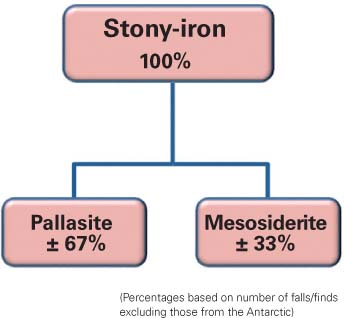
Basic classification of stony-iron meteorites

Bob Falls
Esquel slice of 11kg; 930mm × 370mm
Pallasites are named after the German explorer Peter Pallas, who collected samples of an unusual stone in 1772 that contained both iron and crystalline olivine – the first recognised pallasite. Most pallasites are a mixture of iron-nickel and olivine. The olivine can vary in colour from almost black and opaque to bright yellow, translucent crystals. When the crystals are of gem quality they are known as peridot. Pallasites are thought to have formed near the junction between the metal core and silicate mantle of a differentiated planet, and are among the most popular meteorites, thanks to their unusual appearance. The Esquel and Imilac meteorites from Argentina and Chile, respectively, are two of the most popular and famous pallasites on account of their stability and beauty. A large slice (11kg) of the Esquel pallasite is shown alongside – one of the largest slices of pallasite in the world. It was originally cut from the 755kg Esquel meteorite by Bob Haag, who is pictured with the author on page 57, together holding the piece. The Esquel is regarded as one of the most aesthetic meteorites in the world due to its stunning combination of iron-nickel matrix together with bright yellow/green peridot. Because of its high resistance to rust, this pallasite is also much prized by jewellers who often use small pieces of it in high-end designer jewellery. When set in 24ct gold, this meteorite can make spectacular pieces in which the gold setting is usually the least expensive part. Some hand-made designer meteorite jewellery is shown below, including one item made from Esquel.
More than 60 pallasites are known worldwide and they are, without doubt, among the most beautiful of meteorites when they are cut and polished. They don’t look very appealing when found but, once they are polished professionally and etched to highlight the Widmanstatten lines in the metal sections, they can be quite stunning, as can be seen in the contrasting images on page 58. When thinly sliced, pallasites can make impressive display specimens, especially in cases where the olivine is close to gem-quality peridot (see images on pages 58–59).

Bob Haag
Author and Bob Haag with 11kg Esquel slice

Bruce Cairncross
Reverse polished face of Esquel pallasite shown at top of page

Bob Falls
A thin etched slice of the famous Glorieta pallasite of 78g, from the USA
Bob Falls
Above left: An etched slice of the famous Esquel pallasite of 400g (260mm × 200mm), from Argentina Above right: One of the largest slices of Imilac in the world: 2,800g; 510mm × 470mm. The larger the slice, the thicker it must be to prevent it from breaking. Thicker slices tend to be less transparent and it is unusual to find such a large slice that is still relatively translucent.
Mesosiderites are the second type of stony-iron meteorites and have roughly equal proportions of metal and silicate in the mixture. They are, however, quite unlike pallasites as they are believed to have been formed by impact melting caused by violent collisions between silica-rich asteroids and metal asteroids early in the formation of the solar system (Norton & Chitwood, 2008).
A couple of examples are shown below, which are of the Vaca Muerta from Chile and the Mount Padbury from Australia, respectively. Both specimens have been cut and polished to show their composition. There are fragments of eucrite material in the attractive Vaca Muerta meteorite, the exact origin of which has yet to be fully understood.

Bruce Cairncross
Above left: Vaca Muerta mesosiderite end cut of 1,625g, polished to show its composition Above right: A cut and polished Mount Padbury mesosiderite, 80g
Stone meteorites represent roughly 92% of all finds and falls recovered on Earth (excluding the Antarctic meteorites), although by weight they represent only about 8%. They can be subdivided into two main groups, namely chondrites and achondrites, as shown in the figure below, depending on whether or not they contain chondrules.
Chondrites contain chondrules, which are small spherical grains that were created around 4.56 billion years ago at the formation of the solar system. Everything in the solar system has its origin in such chondrules but, over time, much of the constituent material of chondrules has been altered in some manner, through impacts between asteroids, with the result that these original grains of matter have all melted and no longer exist anywhere today – other than in some meteorites. If stone meteorites contain chondrules, they are usually at least 4.56 billion years old; if they do not contain chondrules, they will be younger – sometimes younger than 1 billion years old.
The presence or absence of chondrules is almost a science in its own right, and their evaluation under a microscope can provide some very interesting and spectacular images. Some meteorite researchers are able to classify a meteorite by examining a small piece ground down to a slice so thin that it almost appears to come from a stained glass window. One particular researcher, John Kashuba, is famous for the spectacular images he has taken of various thin sections, some of which are shown below.
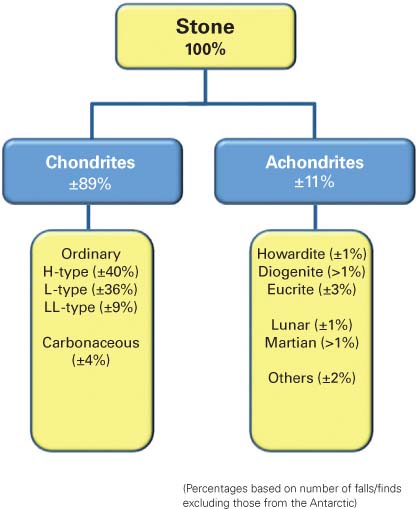
Basic classification of stone meteorites; they are divided into two categories: chondrites, which contain chondrules, and achondrites, which don’t

John Kashuba x4
Above left: A chondrule, 1.8mm in diameter, from the Kilgore 010 CK carbonaceous chondrite. The thin section was photographed under cross-polarised light to enhance the colours and facilitate identification of the constituent materials. Above right: A thin section, just 3mm wide, of the NWA 6704 achondrite – a meteorite that does not contain chondrules. Photographed through cross-polarised filters to enhance the colours, it shows albite, a form of plagioclase feldspar, which appears as the white material between the more colourful grains of orthopyroxene, some of which enclose smaller grains of olivine.

Above left: A barred olivine chondrule, 1.2mm in diameter, from the Dofar 535 LL -type chondrite with a thick rim surrounded by an additional layer of crystalline minerals. Viewed in cross-polarised light. Above right: A thin section viewed in cross-polarised light of the ungrouped achondrite meteorite NWA 7325. The mottled grey mineral is plagioclase, the colorful grains are pyroxene in which the lines denote polysynthetic twinning caused by shock to the asteroid while in space. The field of view is 12mm wide.
Chondrites are by far the most common meteorites, based on the number of recovered falls and/or finds as shown in the chart below. Of these, the most common are the high-iron H -types and lower-iron L -types, with the very low-iron LL -types and the rare carbonaceous chondrites making up the balance. If the same analysis is repeated, based on the weight of the recovered material, the results are quite similar and are shown in the bottom chart.

Breakdown of chondrites based on number of falls and finds

Breakdown of chondrites based on weight (tons)
Most stone meteorites found on Earth are ‘ordinary chondrites’, which are subdivided into a further three basic categories in accordance with the amount of iron they contain. The iron is found in the form of natural iron/nickel particles, or contained in various iron silicates or other iron-bearing minerals. The H-type chondrites contain the highest percentage of iron, which can be up to 30% by weight, of which almost 20% can be in the form of free iron-nickel. The LL -types contain the lowest percentages of iron, which can be below 20% and there may be almost no traces of visible iron-nickel when the meteorite is cut and polished. The iron content of the L -types falls between that of the H and the LL, and the approximate ranges of free and total iron content are provided in Table 3.

Table 3
Although it is not a foolproof test, a collector or meteorite specialist can often judge with reasonable success if a meteorite is an H, L or LL specimen simply by testing the strength of attraction between the meteorite and a strong magnet, since all of the ‘ordinary chondrites’ will be attracted to a magnet to some extent.
There is yet a further subcategory that describes the ‘quality’ of the individual chondrules within a stone meteorite: the numbers 3 to 6 appear after the H, L or LL. If meteorites have experienced some form of shock, either through impact collisions or some form of reheating, the original crystal structure within the chondrules can be altered and, in extreme cases, destroyed completely. Where the chondrules are pristine and unaltered in any way, the meteorite is classified with the number 3, and if the crystal structure of the chondrules has been completely altered it is classified with the number 6. Numbers 4 and 5 represent some level of alteration between the two extremes.
Carbonaceous chondrites, as the name suggests, contain certain amounts of carbon and are among the most interesting to scientists because they sometimes include particles that pre-date the solar system; and, in some cases, they contain amino acids, some of which are unknown on Earth. In view of their rarity and scientific value, the carbonaceous chondrites have been split into more than a dozen different categories, each of which has certain unique characteristics. For the purpose of this book, the different categories of carbonaceous meteorites will not be discussed, and further details can be found in any of the more detailed meteorite books (see Norton & Chitwood, 2008).
Are people ever killed by meteorites?
There is no known record of anyone having been killed by a meteorite. Many people have, however, been injured from the pressure wave caused when a meteor explodes in the atmosphere. Over 1,500 people were hospitalised in February 2013 when the Chelyabinsk meteor exploded and created a huge pressure wave that caused damage to over 20,000 properties. Most of the injuries were from flying broken glass when the shock wave shattered windows.

Koue Bokkeveld meteorite, 80g; 100mm × 50mm
The image above shows an 80g fragment of the Koue Bokkeveld meteorite from near Ceres in the Western Cape province of South Africa (see page 87). Such meteorites are highly prized by collectors and are also of great interest to scientists. Another very famous carbonaceous chondrite is the Murchison meteorite from Australia, which fell in 1968 and is renowned because it contains numerous amino acids, which are the building blocks of life. Many scientists believe that such a meteorite was responsible for seeding life on Earth, and research continues on this meteorite into the possibility that the amino acids it contains can, under certain circumstances, be encouraged to form basic cellular life forms.

Bruce Cairncross
Allende slice of 430g; 300mm wide
One of the most popular carbonaceous chondrites available to collectors is the Allende meteorite, which fell on 8 February 1969 in the small Mexican town of Pueblito de Allende, in the state of Chihuahua. This turned out to be the largest fall of carbonaceous chondrites in history, and several tons of meteorites have been recovered. The image on the above shows the cut face of a large slice from an Allende meteorite, which clearly reveals the chondrules in the dark matrix. This particular meteorite has been the subject of significant research and is of great interest to scientists. It has been found to contain white inclusions of a calcium-aluminium-titanium mineral that pre-dates the solar system and is estimated to be over 5 billion years old, having condensed from the solar nebula before the solar system was ‘born’. Above is a close-up of the previous image; some of the rare white inclusions are visible.

Bruce Cairncross
Close-up of Allende slice in previous figure, 80mm wide

NASA / JPL / MSSS
Photograph of Mars
The initial Viking Mars Lander spacecraft was designed specifically to land on Mars and identify the isotope ratios of hydrogen and heavy hydrogen. Having successfully transmitted the data back to Earth, scientists were able to cross-check it against similar data from a number of ‘unknown’ meteorites already found on Earth, and which did not match anything else from either the Moon or the asteroid belt. By comparing several of the unusual meteorites found on Earth with the data collected by the Viking Mars Lander, scientists were finally able to confirm, with certainty, that they originated from Mars. As a result of this discovery, scientists have been able to examine pieces from Mars without physically bringing any samples back to Earth.

Bruce Cairncross
Part slice of Zagami Martian meteorite of 47g; 75mm × 80mm – from Nigeria
There are currently around 100 different classified Martian falls or finds, with a collective weight of more than 100kg. They have been classified into three distinct groups, which are named after the original ‘type’ specimens that now define the sub-classifications. The three different types of Martian meteorites are the shergottites, nakhlites and chassignites. They are commonly referred to as the SNC group of meteorites, and most of the Martian meteorites that have been found on Earth can be placed into one of these three categories.

Bruce Cairncross
A Martian NWA SAU008 shergottite slice of 17g; 60mm × 70mm
Martian meteorites contain very little iron and are not attracted to a magnet, making them difficult to identify as meteorites unless they have fallen in some area where they stand out clearly.
Two of the most popular and, arguably, most significant Martian meteorites currently available to collectors and scientists are both from witnessed falls, namely the Zagami (top right), which fell on 3 October 1962 in Nigeria, and the Tissint, which fell in 2011 in Morocco (see page 116). Bottom right is a close-up of a slice of another Martian meteorite, the SAU008 shergottite, which is quite different from the Zagami.
Both the Zagami and Tissint are classified as shergottites, with total known weights of 18kg and approximately 20kg respectively, although the official registered total known weight for the Tissint is only 7kg; since it was classified, many other specimens have been found, hence the higher estimated recovered weight. The Zagami was a single stone of 18kg, while the Tissint was a typical fireball, resulting in a strewn field and many hundreds of individual stones. As a result, all pieces of the Zagami meteorite in collections are slices from the same single stone, while the Tissint is available as either fragments or complete stones, many of which have a pristine and shiny black fusion crust.
How do we know that a meteorite originates from the Moon or Mars?
Each planet or asteroid has certain characteristics that are unique, and any material from a parent body will carry these characteristics. In the case of Mars, the Viking 1 & 2 spacecrafts landed on the planet in 1976 and sent back data confirming that certain meteorites found on Earth originated from Mars. Similar data collected by NASA from visits to the Moon and, more recently, by the NEAR spacecraft that flew past Vesta, confirmed the origins of other meteorites.
A more detailed description of Martian meteorites is available on the web site developed by the Jet Propulsion Laboratory in Pasadena, USA. It can be accessed on www2.jpl.nasa.gov/snc.
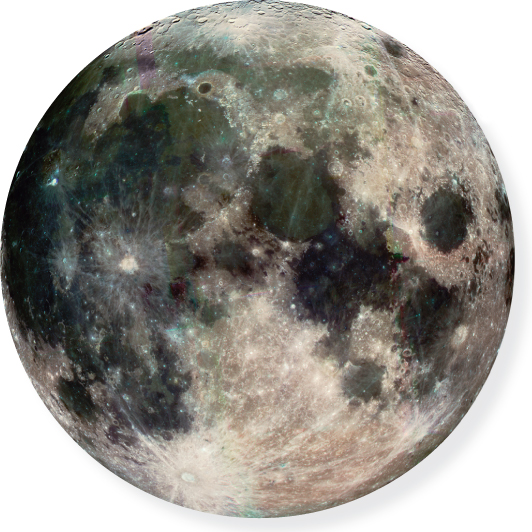
NASA/JPL/USGS
Photograph of the Moon
The first Moon rocks were brought back to Earth in 1969 by the crew of the Apollo 11, who collected approximately 20kg of rock in about 50 specimens. It was not until 1979 that the first Lunar meteorite was found on Earth by Japanese scientists from the National Institute for Polar Research. The Lunar meteorites were found on an ice field in Antarctica, but were only recognised as Lunar meteorites in 1982, after American scientists also identified a meteorite from Antarctica (Allan Hills mountain range) as originating from the Moon. Since then, more than 130 Lunar meteorites have been found on Earth, with a combined weight in excess of 60kg; this can be compared to the total mass recovered by NASA from six separate Moon landings, which is over 380kg.
Lunar meteorites are not magnetic at all and are, in fact, igneous rocks, which do not contain enough iron to be attracted to a magnet and contain no chondrules. They are among the most prized and expensive meteorites available to collectors – often fetching more than $1,000/g.
Lunar meteorites found on Earth have been thrown up into space from the Moon by the impacts it has experienced over time, creating the pitted, pulverised surface we have come to know. The result is that most rocks on the surface of the Moon are breccias, which are basically a mixture of the original igneous surface rocks and fragments of other bodies. The image above left shows the Lunar breccia NWA 2700, while above right is a close-up of a slice taken from the same meteorite.
Bruce Cairncross
Above left: NWA 2700 Lunar breccia meteorite of 24g; 29mm × 23mm Above right: Slice of 2.5g; 29mm × 23mm, of the same meteorite, showing an interesting inclusion and highlighting the highly variable composition of such meteorites

NASA/JPL – Caltech/UCAL/MPS/DLR/IDA
Photograph of Vesta
In 2007, NASA launched the Dawn spacecraft – its mission to travel to the asteroids Vesta and Ceres, located in the asteroid belt between Mars and Jupiter. For many years, scientists had speculated that the HED meteorites (howardites, eucrites and diogenites) all originated from a single planet or asteroid, and that the most likely candidate was Vesta. In July of 2011, the Dawn spacecraft reached Vesta and started a one-year orbiting mission, during which it took many detailed photographs and other scientific readings from a distance of approximately 40,000km.
How fast do meteors travel?
Meteors travel through space at around 40 km/s while the Earth is moving through space at around 30 km/s. A meteor will therefore approach the Earth at between 70 km/s and 10 km/s depending on whether or not it is approaching from head-on or from behind.
Why are all of the 10 largest meteorites made of iron and not stone?
The top 10 largest meteorites known on Earth are all irons due to the fact that stone meteorites are generally unable to survive the huge stresses experienced when a meteor passes through the atmosphere. Most of the stone meteors explode high up in the atmosphere and the resulting smaller fragments then tumble to Earth. Occasionally a large iron meteor will survive the extreme stresses to reach the ground without breaking up into much smaller pieces.

Breakdown of HED meteorites by number of falls and finds

Breakdown of HED meteorites by weight
The data provided by the Dawn spacecraft has now been analysed by scientists, who have confirmed that the HED meteorites do, in fact, originate from Vesta.
There are approximately 650 known HED falls and finds, with a combined weight of over 1.25t, as shown in the above charts.
As is clear from both figures, eucrites tend to be the most plentiful of the HED meteorites, with the balance split fairly evenly between the howardites and diogenites. The total weight of all HED meteorites is relatively small, at just over a ton, of which one find alone – the Millbillillie from Australia – weighed more than 300kg. The HED meteorites do not contain chondrules and are not attracted to a magnet. They generally have very shiny and glassy fusion crusts, which clearly differentiate them from ordinary chondrites.
Howardites, eucrites and diogenites do not contain free iron. When cut and polished they tend to be very light in colour and are generally not as heavy as ordinary chondrite stone meteorites.

Bruce Cairncross
A piece of the Macabeni eucrite from South Africa – 200g; cut face 25mm × 80mm. It may appear more like a howardite than a eucrite. Howardites are considered to originate from the surface of Vesta and contain a mixture of fragments of many different types of meteorite due to repeated impacts on the surface of Vesta by asteroids over several billion years.

Bruce Cairncross
Close-up of a slice of an NWA (Moroccan) 6712 eucrite of 28g; 100mm × 50mm

Bruce Cairncross
Pristine Millbillillie eucrite clearly showing the shiny crust as well as flow lines and lipping, 2,200g; 145mm × 120mm

Bruce Cairncross
Nicely oriented NWA (Moroccan) howardite, 87g; 52mm × 47mm

Bob Falls
End cut from the Millbillillie eucrite, 1,200g, showing the interior

Bob Falls
Weathered outside crust of another howardite (NWA 6817), 650g, from Morocco
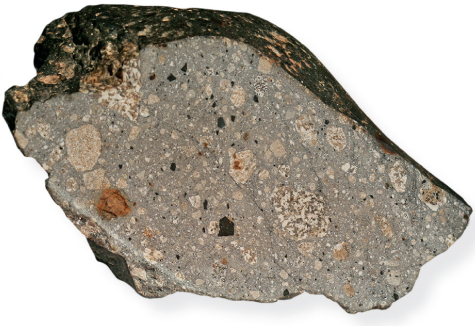
Bob Falls
Interior view of the same howardite, clearly revealing the brecciated structure typical of most howardites